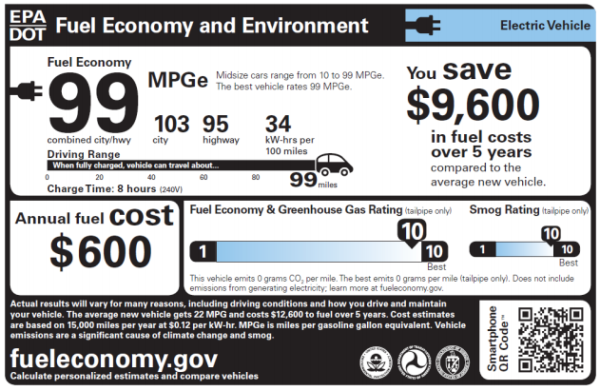Sample Electric Car EPA Sticker
84 miles range for 2013 vs. 73 miles for 2012
Over the past few days we have seen varying reports about the expected range for the 2013 LEAF. Not wanting to speculate, nor provide misleading information using non-standard testing methods, we went to the source – Nissan North America.
We should first say that the EPA range indicated on the 2013 LEAF Monroney (window) sticker is 75 miles. Seeking confirmation regarding potential range improvements for the 2013 model we went to Tim Gallagher, Senior Manager, Nissan Corporate Communications and Tim had this to say – “Under EPA’s testing methodology as adopted for the first time with MY13, the 75-mile range represents a blend between the MY13 LEAF’s 2 charging modes:
- 80 percent Long Life Mode charging: A customer-selected charging mode that can assist in optimizing long-term battery health; and
- 100 percent Long Distance Mode charging: Factory default charging mode to help maximize range”
In other words, if the 2013 LEAF were tested under the same conditions as the 2012 LEAF, the Monroney sticker mileage range would read 84 miles. The breakdown in range estimates for the new EPA testing methodology is as follows:
- 100 percent charge – 84 miles
- 80 percent charge – 66 miles
Add the two together and divide by two, and the blended range of 90 percent (which, by the way, is not a charge option) is 75 miles. We don’t agree with the EPA’s testing methodology. Keep reading for our analysis.
Every manufacturer of electric vehicles (EVs) has the capability of setting limited charge options for their vehicles, should they desire to. They can also choose to offer no alternative to a 100 percent charge. In addition, they can provide indications of varying charge status, but offer no guidance as to recommended percent of charge. Ford’s Focus Electric has no guidance in the owner’s manual for instance, although an indicator provides 25 percent increments to the charge status. In this case, the Ford Focus Electric Monroney sticker would indicate the 100 percent charge as potential range, while the Nissan LEAF would indicate the blended (and non-selectable) 90 percent charge as potential range. Uneducated consumers looking at just the Monroney labels may conclude that the car with the higher indicated range will go farther. Without knowing the precise formula in which the range displayed on the window sticker is derived, it will just become more confusing for the customer. Our position is that the EPA should rate all EV mileage ratings at 100 percent of charge. Our reasoning is simple – all EVs offer the ability to charge to 100 percent. The owner can choose to charge to any lesser value which will provide her with the needed range for her needs. The EPA is trying to think for the customer, when we think the customer is quite capable of thinking for himself.
Oh… and one last thing. If you take a close look at the sample EPA Fuel Economy Label for EVs at the top of this article, you will see the legend “When fully charged, vehicle can travel about…” We don’t believe the EPA’s blended methodology represents a fully charged condition of the Nissan LEAF.


Good observation about the label. There’s clearly a contradiction between what Nissan told you (84 miles range with a full charge) and the EPA label indicating 75 miles range with a full charge (see example here: http://insideevs.com/wp-content/uploads/2013/02/2013-Nissan-LEAF-sticker-S-Model.jpg)
I think that 84 miles is probably the right number since the range improved by about 15% too on the Japanese (JC08) and European (NEDC) testing cycles for the 2013 LEAF. And as far as I know, there was no change in their testing methodology.
And I also agree with you that the EPA average of two charging modes is really a disservice to the consumer!
Gwido, thanks for the feedback. I think that there is enough confustion about electric cars already. The EPA does not need to be adding to it.
Pingback: What to write about — Living LEAF
Pingback: 48 kWh LEAF in your future? — Living LEAF